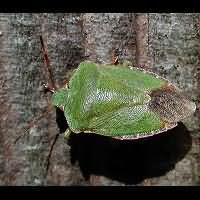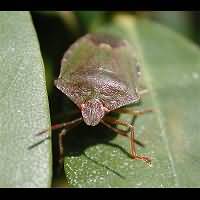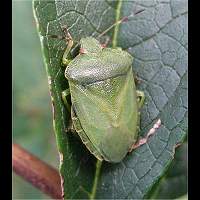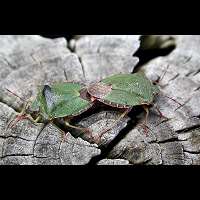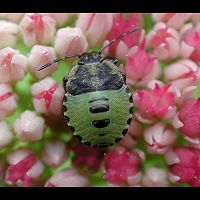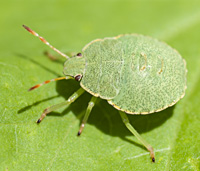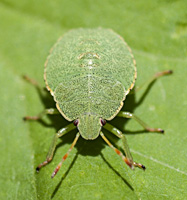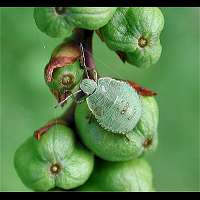[All pictures of garden wildlife on this page are thumbnails. Click on any thumbnail for a large format to be displayed.]
Green Shield Bug (Palomena prasina)
Perhaps the best known of all bugs is this Green Shield Bug, often called the Green Stink Bug. The species is encountered in gardens regularly, especially in spring and autumn. It is bright green and some 12 to 14 mm in length. The adults and larvae both are capable of overwintering. Most of them turn brown just before that. After hibernation it takes them about a week or two to turn completely green again. In the second picture from the top you see ananimal in transition from brown to green. There are a number of other green species looking exactly like the Green Shield Bug. Most of them are not as common in Europe and absent on the British Isles. Many of these species can be told apart by studying the colours and length of the segments of the antennae.
Green Stink Bugs mate by establishing contact between their rear end opposing eachother. This is common in bugs. The male doesn't climb on the female, making it very difficult to tell which is the male and which is the female. Actually the two sexes do not show any difference in appearance. The female lays her eggs in small groups on the reverse side of a leaf. The young that hatch do not look like their parents at all, for they are wingless and green with big black spots. Very soon they change their skin for the first time.
After changing their skin for the first time, the larvae become green with less black markings. After a few skin changes more, the black disappears and the young turn completely green, except for some small white or light green markings on the back. If necessary the young may overwinter as well and they also turn brown in such an event. This species often overwinters in small groups. It is a remarkable phenomenon that in such a group usually one or two animals didn't turn brown and overwinter in their original green colour. We do not know why that is so. The nymphs look like beetles very much and many people actually report them as unknown beetles. But when you look closely you will see that the larvae lack the seam found on beetles where the two shields meet. Once you know this you can tell bug larvae apart from beetles by just one glance.
This species is not called Green Stink Bug for nothing. First of all it is green indeed and secondly it produces a foul smelling liquid. That's why it is such an unwanted animal. It not only produces this bad smell when in danger, like lady beetles do. Everywhere it goes it leaves behind a stinking trail. You often notice this picking blackberries. Suddenly you pick a smelly one, tasting awfully when eaten. Usually a Green Stink Bug was there before you were. Green Shield Bugs have only very few natural enemies. It is a very common species all over the British Isles and on the continent as well.
Green Stink Bugs mate by establishing contact between their rear end opposing eachother. This is common in bugs. The male doesn't climb on the female, making it very difficult to tell which is the male and which is the female. Actually the two sexes do not show any difference in appearance. The female lays her eggs in small groups on the reverse side of a leaf. The young that hatch do not look like their parents at all, for they are wingless and green with big black spots. Very soon they change their skin for the first time.
After changing their skin for the first time, the larvae become green with less black markings. After a few skin changes more, the black disappears and the young turn completely green, except for some small white or light green markings on the back. If necessary the young may overwinter as well and they also turn brown in such an event. This species often overwinters in small groups. It is a remarkable phenomenon that in such a group usually one or two animals didn't turn brown and overwinter in their original green colour. We do not know why that is so. The nymphs look like beetles very much and many people actually report them as unknown beetles. But when you look closely you will see that the larvae lack the seam found on beetles where the two shields meet. Once you know this you can tell bug larvae apart from beetles by just one glance.
This species is not called Green Stink Bug for nothing. First of all it is green indeed and secondly it produces a foul smelling liquid. That's why it is such an unwanted animal. It not only produces this bad smell when in danger, like lady beetles do. Everywhere it goes it leaves behind a stinking trail. You often notice this picking blackberries. Suddenly you pick a smelly one, tasting awfully when eaten. Usually a Green Stink Bug was there before you were. Green Shield Bugs have only very few natural enemies. It is a very common species all over the British Isles and on the continent as well.

© Copyright 1998-2024 gardensafari.net (Hania Berdys)

 English / engels
English / engels  Dutch / nederlands
Dutch / nederlands